 |
The before-math
Alan Turing wrote this paper while employed at the Computing Laboratory in Manchester University. This was where the world's first stored-program digital computer had been engineered. See the previous Scrapbook page for the relationship between Turing and his universal machine, the mathematician Max Newman, and the engineers led by F. C. Williams.
The prospect of Artificial Intelligence was raised as an issue for the general public from the very start, stimulated by the success of wartime science technology. In 1949 the brain surgeon Geoffrey Jefferson spoke out against it in a lecture 'The Mind of Mechanical Man'. In response, Turing told the London Times that 'their research would be directed to finding out... to what extent [the machine] could think for itself.' Of course, this was in no way the official purpose of the Computing Laboratory, and was at variance with anything Newman or Williams would have said. Controversial and provocative, Alan Turing went on to write the 1950 paper as his own individual contribution, making very few references to other people's ideas.
Nevertheless, Turing had some useful external stimuli. Besides Jefferson and Max Newman, the chemist and philosopher Michael Polanyi, and the zoologist and neurophysiologist J. Z. Young, were active participants in discussions with him. A large interdisciplinary Discussion on the Mind and the Computing Machine was held at Manchester on 27 October 1949.
See the original transcript of this discussion.
Reading the transcript is rather like reading the conversations generated by computers, described on the next page. Few of the discussions can stick to a point or actually address a question! But it is nevertheless a striking document. From the discussion of Gödel's theorem, to the reference to 'neural networks, to the connection with detailed brain physiology, all the topics are completely relevant today. In the midst of this came a joke against Turing (and perhaps Newman): the question 'Are mathematicians human beings?"

Such 'murmurs' are liable to provoke a revolt of the nerds, and Turing was entirely willing to be the revolutionary. He was fully aware that his propositions contradicted widely held assumptions about the uniqueness of human abilities and happily called himself 'a heretic' putting forward an unpopular view.
Turing's discussion of 'intelligent machinery' did not begin in 1950. It went back to to the 1936 Turing machine modelling the human mind, and the developments which flowed out of wartime work at Bletchley Park. Turing's 1950 paper is best read as the successor to two earlier papers, unpublished in Turing's own lifetime. These were a 1947 talk and a 1948 report, both accessible in the Turing Archive. These have more technical and mathematical detail, and add much to the 1950 paper. However, the 1950 paper was the first properly published work. See the Bibliography on this site for full references.
The after-math
According to a letter to Turing in the Turing Archive, [see item 5a], Bertrand Russell 'enjoyed it very much'. Turing's argument was of course in line with Russell's materialist and atheist philosophy, and indeed Turing poked fun at religion in this paper, albeit somewhat superficially.
The BBC invited him to give a talk on its new highbrow radio Third Programme in 1951. The producer had doubts about his talents as a media star, writing that he

Turing took part in a further radio discussion in January 1952.
FAQ: was any recording kept of these broadcasts?
Answer: No. And there is no known recording of his hesitant voice. But the scripts can be read in the Turing Archive: 1951 talk and 1952 discussion.
Both broadcasts have further points of interest regarding Turing's discussion of Artificial Intelligence. So do two further Turing texts: he gave another 1951 lecture entitled Intelligent Machinery: A heretical theory, and wrote an article on computer chess-playing. The original typescripts of these can also be seen in the Turing Archive. See the bibliography for full references.
|
What Turing had in mind
But it was in the 1950 paper that Turing held, most fully and confidently, that computers would, in time, be programmed to acquire abilities rivalling human intelligence. Even where he saw difficulties and was doubtful about what could be achieved, he advocated experiment. He saw this not a dogma, but as an important conjecture, to guide future research.
The paper has many aspects to it, including
- An exposition of the discrete state machine model, which gets away from all earlier discussion of homunculi, life forces, etc. etc. and places the discussion within a clear logical framework.
- A rather corner-cutting account of computability and the universal machine as Turing had discovered in 1936.
- Answers to many specific objections to the prospect of 'intelligent machinery', broadly reflecting discussions such as that held in 1949.
- Constructive suggestions for how Artificial Intelligence might be arrived at, including what are in modern terms both top-down and bottom-up approaches.
But the most famous element of his paper lies in his Test. Turing put forward the idea of an 'imitation game', in which a human being and a computer would be interrogated under conditions where the interrogator would not know which was which, the communication being entirely by textual messages. Turing argued that if the interrogator could not distinguish them by questioning, then it would be unreasonable not to call the computer intelligent, because we judge other people's intelligence from external observation in just this way.
The Test allows Turing to avoid any discussion of what consciousness is. It seems to provide a scientific, objective, criterion of what is being discussed — but with the rather odd necessity of 'imitation' and deceit coming into it, for the machine is obliged to assert a falsity, whilst the human being is not.
Turing's 'imitation game' is now usually called 'the Turing test' for intelligence.
Wearing well
The Turing Test has given rise to a large literature, surveyed by:
Turing's paper is still frequently cited and people still discover new things in it.
It has certainly generated an enormous number of academic discussions. One such was the 1990 conference for its 40th anniversary. I was wearing the tee-shirt from this conference when photographed in 2002 at the Lausanne conference marking Turing's 90th birthday. Whether any real progress has been made towards actual Artificial Intelligence is doubtful. |
Developments
Superintelligence
Turing envisaged in this paper that machine intelligence could take off once it reached a 'critical mass'. This picture is expounded in a science-fiction novel, The Turing Option, by the AI pioneer Marvin Minsky.
In 2008, Ray Kurzweil received much media attention for speaking at an American Association for the Advancement of Science meeting and saying that human-level AI would be achieved by 2030.
The logical consequence of this thesis is that machines would not merely match but would surpass human abilities. Transhumanists take this as a completely serious starting-point. Thus the Singularity Institute for Artificial Intelligence states that 'In the coming decades, humanity will likely create a powerful artificial intelligence. The Singularity Institute... exists to confront this urgent challenge, both the opportunity and the risk.' This is apparently taken seriously by the British government now.
The article How long before superintelligence by
Nick Bostrom gives essentially the same argument as that of Turing's 1950 paper, though without worrying so much about the objections. So does When will computer hardware match the human brain? by Hans Moravec.
Turing estimated 1010 bits of storage to be sufficient, but of course this now seems ridiculously low for computer storage. Modern writers now give other figures and use Moore's Law to estimate future power. In one way Turing's predictions certainly fell short of what has happened in 50 years, because miniaturisation has gone far beyond what he imagined possible. He was right, though, in citing the finite speed of light as an essential factor determining constraints on technology.
Child machines, learning, top-down and bottom-up
Turing's paper outlined both explicit programming ('top-down' in modern terms) and learning processes ('bottom-up') as approaches to creating AI. This AI research group make a lot of Turing's picture of imitating human learning and have a "child-machine" called HAL.
Until about 1990, top-down and bottom-up AI research groups were hardly on speaking terms. Since then there has been some confluence and synthesis of strategy, reflecting much better what Turing recommended in 1950, that 'both approaches should be tried'.
|
The Chinese Room
Other philosophers completely disagree with the entire programme for Artificial Intelligence, developing the argument that Jefferson (and Wittgenstein) began. The 'Chinese Room' story of John Searle gives the most famous argument against the validity of Turing's test. |
Mind, computability and physics
The restriction to textual communication is now less significant, as computer files are used for all the media and sensory inputs of 'virtual reality'. A suggestion for an Ultimate Turing Test exploits this fact. What this shows
is that the mathematics of computability is the real bedrock on which the whole question rests. Anything a computer can do is computable; anything computable can be done on a computer (as a universal machine); if what the brain does is computable it can be imitated by a computer. That is the fundamental argument.
Turing himself argued in this paper that the question of uncomputability in mathematics was not in fact relevant to the question of mental faculties. In 1961 the Oxford philosopher J. R. Lucas published a paper on the significance of Gödel's theorem which argued to the contrary. Gödel himself also criticised Turing's assertions about human minds in the 1960s.
Turing's view was defended by his wartime colleague, the mathematician and statistician I. J. Good. It was later much elaborated by Douglas Hoftstadter in his 1979 book Gödel, Escher, Bach.
In 1989, Roger Penrose published The Emperor's New Mind which took a completely fresh approach, connecting uncomputability with unknown laws governing quantum physics. His work Shadows of the Mind followed in 1994, making a specific suggestion about the physics of the brain. A good entry point into this argument is the on-line paper
Beyond the Doubting of a Shadow, Penrose's response to criticisms of Shadows of the Mind.
Nowadays the thesis that no physical process can go beyond the bounds of computability, is known as the Physical Church-Turing thesis. In discussing the 'Argument from Continuity of the Nervous System', Turing's 1950 paper comes very close to asserting this thesis. But this is one area where Turing's post-1950 texts are well worth studying, because in the 1951 radio talk, Turing briefly gave a different discussion, this time bringing in the difficulty posed by quantum mechanics. This radio talk also expressed more concern about the significance of uncomputability.
|
In Alan Turing: the Enigma, I discussed Turing's paper in the light of what seemed to me to be Turing's own doubts about AI — doubts centred on the serious problem of where to draw a line between thinking and living.
My later short text on Turing as a philosopher
is more influenced by Roger Penrose's discussion of computability and consciousness, in its discussion of the Turing Test.
|  |
|
The poly-math
Turing's vivid imagery has stimulated many people from beyond the fields of computer science and philosophy.
From strawberries and cream to the place of women in Islamic theology, all human life is there. Highly unusual in its non-scientific references, it has become an icon of user-friendly science.
Arthur C. Clarke was influenced by it, I think, in creating HAL for 2001. (When disabled, HAL reverts to its early childhood.)
See Clarke's foreword to a book on HAL's Legacy.
| C U L T U R E C L A S H: S C I E N C E A N D A R T S |
|
The witty and irreverent style of his paper leaves a vivid picture of Alan Turing's own intelligence, not filtered through academic prose, but as if talking with Cambridge friends. Or, perhaps, anticipating the techie, Trekky, trackie style of net-talk, cocking a snook at the Shakespeare-brandishing culture of official Literature. You can almost see the : - ) and ; - ) in his symbols. |
 |
Alan Turing in the bottom row of a 1951 group photograph of an inter-disciplinary cybernetics meeting acting... |
|
It is not at all like a stereotyped picture of a mathematician thinking about computers.
A good sense of humour is essential to the computer's replies in Turing's sample conversations.
There is also a definitely camp humour in Turing's paper, reflecting his gay identity, and this has led to...
|
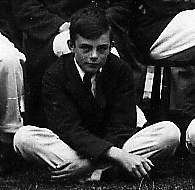 |
...the cross-legged boy at Sherborne School in 1926, disgracing himself in English.
("Are mathematicians human?")
|
Some pink herrings
There are endless possibilities within Turing's paper for drawing cultural connections. For example, the French philosopher Jean Lassègue, writes in Tekhnema, 3, 37-58, (1996) that 'The imitation game 'should be considered as an unconscious and mythical autobiography and not as a philosophical introduction to the main issues of AI.' Turing's circumcision plays a prominent part in Lassègue's account, which has given rise to further discussion.
One particular element of Turing's discussion elicits the most comment from cultural commentators. This is that
Turing started his paper by describing a game in which a man and a woman compete under these remote-terminal conditions to convince an interrogator that they are the woman.
This introduction to the 'imitation' principle confuses the point Turing wanted to assert, that a computer showing intelligence under these conditions must be counted as intelligent. The principle is undermined by the gender game: for this if won by the man, it certainly doesn't prove the man is really a woman.
What he claimed was that with intelligence, as opposed to sex, imitation is as good as the real thing. Turing stressed that the setting of the Turing test, with communication only by symbols, is designed to give a way of distinguishing intelligence from other human characteristics. His irrelevant gender game distracts attention from this point.
Another problem with this bad analogy is that it has led people into thinking that the Turing test means a complicated scenario with the computer taking the part of a man who is pretending to be a woman. Well, he was asking for trouble by bringing sex into it....
|
| T U R I N G T E S T A S T H E A T R E |
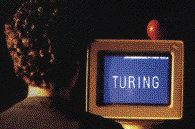 | Turing enjoyed dramatising intellectual argument, as in the theatre of Bernard Shaw, whom he admired. Turing's playful ideas and provocative images have even more powerful resonances today when computers have come to dominate the means of communication... | 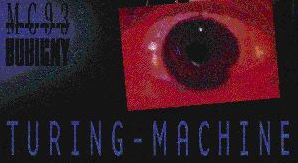 | Play of IdeasThis dramatic production by Jean Peyret, ranging over many issues in science and sexuality, is an example of an artistic response. | Turing's democratic and open approach to 'testing' intelligence invites everyone to share and respond. |
| Sexuality has been transformed between 1950 and 2000 ... and the computer is playing a part in the process. Communication through computer terminals, a science-fiction idea in 1950, has long been possible on the Internet.
The chatline experience, communicating through symbols alone, leaving out the physical cues, raises questions about truth and reality (and intelligence, or lack of it). People say things in these conditions that they would never say 'in real life', and tell a machine things they would never tell a living soul. First on
Internet Relay Chat, where chatbots first made an appearance, and now in countless web-based chatrooms, many people have experienced the subtleties of text-based reality and imagination.
People behave like machines... acting, obeying orders, imitating, role-playing... Turing's iconoclastic images have certainly given encouragement to feminist writers... |
 | ...who want to see technology breaking out of traditional male preserves... |
|
And an opera by Scottish musician Julian Wagstaff: The Turing Test Opera.
|
 |
|
But the real drama lies in the natural wonder of science.
How can a collection of atoms be a thinking machine, asked Eddington.
This was Turing's question, and it ranks with the origin of the universe,
the nature of elementary particles and forces, the origin of life... |
Natural language
The Turing Test is a thought experiment, but that has not stopped people trying it out in practice.
The humour in Turing's original 1950 paper
had a serious point. He was making it very clear that what he meant by 'intelligence' was something that could make a joke, connecting with the real language of real human life.
Humour is alive and well in the various programs that have been running under (approximate) Turing Test conditions in the years since then. These efforts have also been a large factor in keeping Alan Turing's name in the public mind.
Serious Artificial Intelligence people generally take a dim view of these efforts as a distraction from systematic research. But it can be said that they oblige us to keep in mind the original force of the word 'intelligence'. In modern terms, success in such competitions demands effective Natural Language Processing.
Lost in translation
This problem is closely connected with the serious business of translating texts from one human language to another — a topic Turing had mentioned in 1948 as being a core topic for 'intelligent machinery', but which he never developed. Efforts at machine translation run into the same problems of encapsulating real meaning and understanding. Humour and sex naturally accentuate these problems!
|
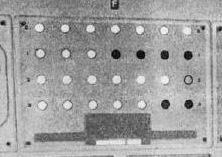
The display screen of Nimrod. This electronic machine played NIM with the public (including Alan Turing) at the Science Museum during the 1951 Festival of Britain.
This machine would always win if it could, because it carried out a well-known winning algorithm. In 1951 this might have seemed an impressive feat of a futuristic 'electronic brain', but nowadays such feats are taken for granted. The point of Turing's test was that a machine would have to compete in game-playing tasks in which human beings are natural champions, and where there is no clear way to program it.
|
|
Love letters, love numbers
Alan Turing's 1951 radio talk, based on his 1950 paper, stimulated a proposal from Christopher Strachey to apply his ideas.
Strachey's letter can be read in the Turing Digital Archive (see items 3a-3d on this page).
His first work was on a program to play draughts. Then in 1952 Strachey developed his ideas by writing a program to generate Love Letters on the Manchester computer. Turing joined in the fun: the hilarity must have been heightened by their both being gay. The love letters featured in early articles of the 1950s about computers. Strachey became a notable figure in British computing for the next 25 years.
Dr David Link has recreated the program, run on an emulator of the Manchester computer. See his page, with an on-line Java version of the program, and his complete article.
| An example:
JEWEL HONEY
MY DARLING HUNGER SIGHS FOR YOUR SYMPATHY. YOU ARE MY SEDUCTIVE PASSION. MY LOVESICK ARDOUR WOOS YOUR FONDNESS. YOU ARE MY IMPATIENT HUNGER: MY SWEET EAGERNESS.
YOURS FONDLY
M. U. C. |
Shrink-rapt
The ELIZA imitation psychiatrist program written in 1966 by Joe Weizenbaum, a notable AI sceptic. The whole point of ELIZA was to demonstrate that a quite trivial program, making quite hopelessly stupid conversations, would fool people if they were told it was a psychiatrist.
You can still talk to ELIZA here.
|
The Loebner test
Turing's 1950 paper had made a specific suggestion that within 50 years a computer would pass a (actually not very stringent) comparison test. Anticipating this millennial deadline, in 1991 the entertainment entrepreneur Hugh Loebner decided to fund a series of actual competitions. The call went out for entries to a contest under Turing Test conditions. More precisely, the conditions were less stringent than Turing's for the first few years, allowing the conversations to be restricted to special subjects. | The call document was one the first uses of the early Web protocols. The 1991 page was still on-line in the late 1990s, but now, alas, it is swept into cyber-oblivion. |
|
The Loebner Prize Contest has continued each year. It has become remarkable as the contest of a few very dedicated people, trying again and again with improved versions of their work.
In November 1991 the
winning program was by Joseph Weintraub on the topic romantic conversation, and he was the winner again in 1992 and 1993.
In 1994 the
Loebner Prize Winner was Thomas Whalen. The topic of this computer program was sex.
There's a lively discussion of these contests and dialogues by Charles Platt, one of the people who were claiming to be genuine humans in the 1994 competition.
|
For many years after 1994, Whalen's program was available on the early Web as a TELNET application. Again, alas, it has disappeared.
I asked how to find a boyfriend and got the answer 'Go to church.' Was it making a joke?
|
In the 1995 contest, Joseph Weintraub regained supremacy.
For the first time the programs entered were not limited to a subject. But as you will see from the
transcript,
sex still dominated the conversation.
The 1996 contest was won by Jason Hutchens with a conversation which you can read. The program fails hopelessly when the judge insists on sticking to a point. Read his description of how it works.
Here are suggestions for good questions to ask.
|
After fifty years
The competition for 2000, the fiftieth anniversary of Turing's prediction, was held at Dartmouth College, New Hampshire,
where (by people who forget Turing and Strachey and several others), Artificial Intelligence is supposed to have begun in 1956.
No program entered for the competition came close to deceiving the judges., but the winner was A. L. I. C. E. by Richard Wallace.
You can chat to a now highly commercial A. L. I. C. E. here.
|
|
In 2008 the contest was held at the University of Reading, in England. A BBC report, with audio links, is here. There was a parallel conference at Reading of scientists and philosophers, organised by the Society for the Study of Artificial Intelligence and Simulation of Behaviour. I gave a talk at this meeting, published as an article 'Fair play for machines', Kybernetes 39, 441 (2010), and I also briefly figured as a hidden human being. (I was correctly judged to be such by an Oxford philosopher, which ranks as quite an achievement.) | 
The screen I talked to. |
|
In 2014 there was another such event at Reading, with even more hype surrounding the supposed breakthrough that was demonstrated. See here and here for sceptical reactions.
|
Alan Turing's New Life
It is a surprising fact that Alan Turing himself did not use the Manchester computer to develop his ideas for 'intelligent machinery'. Nor, indeed, did he spend much of his time after 1948 in developing his theory. David Deutsch, in The Fabric of Reality, paints a picture of Turing having to sacrifice years to defending his philosophical position, but this is far from the case. Indeed, after 1950 he largely abandoned the development of computer science. Instead, he went on to something quite new.
|
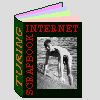
Continue to the next Scrapbook page.
|
|
|